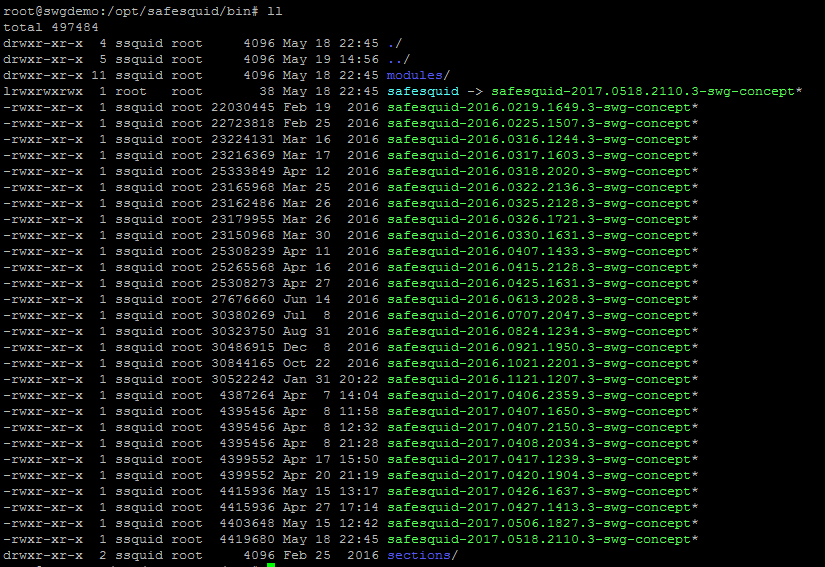Disk space and RAM is full on SafeSquid server
Overview
Manage disk space on SafeSquid server. When any of the partitions that are used by SafeSquid are full, it results in undefined behavior. This may lead to something like, SafeSquid failing in processing the connections.
Prerequisites
Give the enough size to backup store.
Example : If you want to take a backup of files of size 5GB then consider the store upto 5.5 GB
Don't delete the original log files (.log extension) and database files.
Check disk space
Run below command to check available disk space on each partition.
df -kh
You will see the Used and Available size on each partition.
| Filesystem | Size | Used | Avail | Use% | Mounted on |
|---|---|---|---|---|---|
| udev | 735M | 4.0K | 735M | 1% | /dev |
| tmpfs | 150M | 428K | 149M | 1% | /run |
| /dev/dm-2 | 4.9G | 4.2G | 424M | 91% | / |
| none | 4.0K | 0 | 4.0K | 0% | /sys/fs/cgroup |
| none | 5.0M | 0 | 5.0M | 0% | /run/lock |
| none | 746M | 0 | 746M | 0% | /run/shm |
| none | 100M | 0 | 100M | 0% | /run/user |
| /dev/sda1 | 232M | 37M | 179M | 17% | /boot |
| /dev/mapper/dev--vg-var+cache+safesquid | 1.8G | 2.8M | 1.7G | 1% | /var/cache/safesquid |
| /dev/mapper/dev--vg-usr+local+safesquid | 1.8G | 44M | 1.7G | 3% | /usr/local/safesquid |
| /dev/mapper/dev--vg-var+db+safesquid | 15G | 193M | 14G | 2% | /var/db/safesquid |
| /dev/mapper/dev--vg-var+log+safesquid | 15G | 171M | 14G | 2% | /var/log/safesquid |
| /dev/ram1 | 62M | 1.3M | 58M | 3% | /tmp/safesquid |
If any of the above partitions are observed to be used over 80%, then you may take backup of the following files and delete files as per your requirement.
Partitions
When "/ " partition is full remove the files in below paths:
/opt/safesquid/bin
change the directory to /opt/safesquid/bin by using below command
cd /opt/safesquid/bin

The default files and folders are :
- sections
- modules
- safesquid -> safesquid-2017.0518.2110.3-swg-concept*
- You should not delete the tar file which is soft linked to SafeSquid file. In the above image it is : safesquid-2017.0518.2110.3-swg-concept*
/var/log
You can also take the backup of system logs and delete the files with .gz extension. This folder contains the logs related to system, so don't delete or modify the original files (i.e. with .log extension).
Example : dmesg.1.gz
/var/cache/safesquid
Delete all files from this folder by using below command. No need to take a backup of any file from this folder
rm -rf *
/var/db/safesquid
Delete all files except these three files from the directory : /var/db/safesquid/report/
- safesquid2.db
- safesquid2.db-wal
- safesquid2.db-shm
These files will be used to store the data required for reports generation
you can take a back up or directly delete these files.
Note : If you delete or moved the above files to other destination then restart the SafeSquid server, in order to create the deleted or moved files.
/var/log/safesquid
Change the directory to :/var/log/safesquid/native/ by using below command
cd /var/log/safesquid/native/
- Native logs used to store the data related to requests and responses. You can delete all files in this folder, No back up is required.
- Example file name to be deleted : 20161223132118-safesquid.log.gz
Change the directory to : /var/log/safesquid/extended/ by using below command
cd /var/log/safesquid/extended/
- Extended logs used to store the data related to users information for each connection. Take a backup of these files if required.
- Example file name to be deleted : 20161223132118-extended.log.gz
Change the directory to : /var/log/safesquid/performance/ by using below command
cd /var/log/safesquid/performance/
- Performance logs used to store the data related to safesquid performance statistics. You can take a backup if required and delete.
- Example file name to be deleted : 20161223132118-performance.log.gz
Change the directory to :/var/log/safesquid/config/ by using below command
cd /var/log/safesquid/config/
- config logs used to store the data related to safesquid interface requests and responses. No need to take a back up of these files.
- Example file name to be deleted : 20161223132118-config.log.gz
/tmp/safesquid
Delete all files and folders present in this directory. By using this command
rm -rf *
This memory will be used only in upgradation time